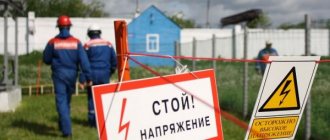To work with electrical installations of any type, you must have sufficient qualifications and have certain knowledge of safety precautions. If to confirm your professional education it is enough to present a diploma, then with the certificate of the electrical safety group, not everything is so simple. What is the peculiarity of the admission and what is the procedure for assigning it, we will describe in detail in the publication below.
Access groups for various categories of personnel
According to the IPBEE (Inter-industry Occupational Safety and Health Rules), production personnel whose professional activities are related to electrical installations of any type are usually divided into three categories:
- Electrotechnical.
- Electrotechnological.
- Non-electrical.
Let's consider the features of assigning an electrical safety permit.
Electrotechnical
For this category, electrical safety approvals from II to V are assigned, depending on the specific requirements for personnel. It, in turn, according to the IPBEE, is usually divided into the following subcategories:
- Administrative and technical . These are specialist managers whose responsibility includes organizing the maintenance process, as well as the operation of electrical equipment, including installation, adjustment and repair. The electrical safety clearance assigned to responsible managers must be no lower than that of subordinate production personnel.
- Operational. The personnel included in this subcategory are engaged in operational and technical maintenance of equipment that is part of the organization’s electrical facilities. In addition, the tasks include carrying out inspections and operational reconnections, as well as preparing workplaces (de-energizing, installing portable grounding, warning signs, etc.).
Installation of portable grounding - Repair . Workers in this subcategory are assigned tasks related to installation and repair work and reconstruction of electrical installations. Repair personnel include employees of instrumentation and control equipment, measurement laboratories and other services of relevant specialization.
- Operational and repair room . It includes electrical personnel assigned to specific areas. For example, shop electricians who specialize in servicing certain electrical equipment.
For independent activities, the last three subcategories must have a tolerance of at least 3, if the work is carried out with a voltage class of up to 1000 V. Accordingly, to carry out work with a higher voltage, it is necessary to have at least the IV tolerance group.
Electrotechnological
This category includes personnel whose professional activities involve the use of equipment powered by electrical energy. Examples include welding machines, as well as manual and stationary electrical equipment. Personnel are allowed to work after being assigned the 2nd qualification safety group.
Non-electrical
This definition includes personnel not included in the two previous categories. They are assigned the 1st clearance group. Which professions are included in this category is determined by the head of the enterprise.
Certain types of work permitted for the third group
Grounding. An electrician with the third electrical safety group can independently apply grounding in electrical installations up to a thousand volts. It is possible to remove grounding connections and disconnect grounding blades with group 3 in electrical installations of any category.
Checking for no voltage. In electrical installations up to 1000 V, one person with electrical safety group III or higher can check the absence of voltage with a two-pole indicator.
Measuring insulation resistance with a megohmmeter. Measuring insulation resistance with portable megohm meters can be performed by persons with electrical safety group III.
As can be seen from all of the above, an electrician with electrical safety group III from among the repair or operational personnel has all the necessary rights to perform work in electrical installations up to 1000 V
Purpose and order of assignment
All employees of the enterprise must undergo certification of knowledge of electrical safety standards within the framework of their professional activities. A specialist cannot begin work duties without being assigned the appropriate qualification group. How a permit is assigned is indicated in PTEEP or other technical literature, which contains excerpts from regulatory documents.
Example of a publication with excerpts from PTEEP
We will briefly introduce you to the procedure for assigning each qualification group.
1 group
The group in question should be assigned to employees whose activities are not related to the use of electrical equipment. In essence, assignment is a preliminary (primary) briefing, at the end of which an oral interview is conducted, which is recorded in the briefing log. Workers are taught the basics of TB, the dangers of electrical voltage and how to provide first aid in cases of electric shock.
List of rules for providing first aid in case of electric shock
According to safety standards, instruction with subsequent assignment of the 1st qualification group can be carried out by an employee appointed by order of the head of the enterprise. A mandatory requirement for an instructor is clearance group 3 and above.
After a group is assigned to non-electrical personnel, they are still required to undergo regular and extraordinary briefings, which is recorded in the log.
Video: electrical safety briefing (assignment to group 1)
2 groups
Assignment of qualification group 2 is carried out to employees of electrical and electrical engineering personnel. According to the Rules, an employee applying for certification must complete 72-hour theoretical knowledge training courses. This requirement does not apply to those who have received an electrical engineering education, since the vocational training program includes obtaining the necessary knowledge, including electrical safety.
To assign an access group to electrical engineering personnel, the latter must have 1-2 months of production experience. For employees included in this category, group 2 is the maximum.
As for employees belonging to the electrical category, for them the group in question is minimal. Without receiving it, they cannot start work. For example, persons undergoing industrial training or practice are in the first group, and, according to the current Rules, are not allowed to operate any electrical installations, even under supervision.
After employees are assigned the 2nd electrical safety permit, they can begin maintenance of de-energized equipment and electrical facilities of the enterprise, but only under the supervision of employees with a qualification permit of at least 3.
Certification for the assignment of a permit is carried out by a special qualification commission of a production organization or a local branch of Rostechnadzor. The commission checks the theoretical knowledge of the principle of electrical equipment on which the employee will work, as well as the skills of providing first-aid care.
Obtaining this qualification permit is not necessary for non-electrical personnel, but in some cases, by decision of management, even loaders may be required to receive group 2.
Please note that the Rules do not allow employees to be assigned a group higher than 2 if they have not reached the age of majority (18 years old).
Recertification, in order to test knowledge of safety standards, is carried out every year.
3 groups
Only a commission appointed by the management of the enterprise or the regional branch of Rostechnadzor can assign the 3rd qualification group, as well as the 2nd. This permit is issued to electrical technical personnel, which gives workers the right to independently service electrical equipment with voltages up to 1.0 kV.
To obtain the 3rd permit, a certain amount of work experience in the 2nd electrical safety group is required. The duration of training is set depending on the qualification level. For example, assignment to an engineer is usually made after a month of work, while college graduates receive the 3rd group no earlier than six months later.
The commission checks knowledge of electrical engineering, the design of electrical equipment, and the features of its maintenance, the ability to free a victim from the effects of electric current and provide first aid.
Certification for obtaining a security group
4 groups
The main difference from the previous permit is that it allows maintenance of installations above 1.0 kV, that is, it is allowed to work with any high voltage. In addition, persons with appropriate qualifications can train personnel, conduct instructions, and also carry out knowledge testing after special industrial training. Engineering and technical workers with this category of admission can be appointed responsible for the technical condition of the electrical equipment of the enterprise.
Qualification group 4 is assigned only to those persons who have worked for at least a quarter with a 3rd electrical safety approval. Quite serious requirements are placed on applicants to take the exam. The examinee must have information on the entire basic electrical engineering course and the main provisions of the PUE. Know the general and job instructions for safety, maintenance of entrusted electrical equipment, as well as know its electrical circuits and understand the principle of operation.
5 groups
This level of highest clearance implies maximum responsibility. Therefore, applicants are subject to all the above special requirements, plus knowledge of the design of equipment used in the entrusted electrical facilities. The certified person must understand the principle of operation of any electrical installation on his site, and, if necessary, be able to determine the cause of the malfunction and find the optimal way to solve the problem.
To obtain a 5th qualification permit, you must have the required qualifications and a certain amount of work experience with the 4th security group (from 3 months to two years, depending on the internal regulations).
Qualification Requirements
| Access group | Requirements for the applicant |
| II | understanding of the principles of operation of electrical equipment; knowledge of the risks when operating installations that are energized; mastering safety precautions (HS). |
| III | knowledge and understanding of the features of various electrical installations, their design, principles of operation, maintenance; correct assessment of the risks associated with working with electrical equipment; mastering the skills of supervising people who work with equipment. |
| IV-V | in-depth knowledge of the operation and design of equipment; mastering general labor protection rules when working with live equipment; mastering safety precautions and skills in organizing events to improve safety; ability to instruct employees on safety issues and supervise their work; skill in training employees in safety regulations. |
Specialists of any group must be able to provide first aid in case of electric shock.
Required documents
Regardless of which organization is engaged in the education of employees and issues permits, the employee or manager needs to prepare a small set of documents. They will be required both for obtaining admission (identity confirmation, employment in a specific position), and for assessing experience and education:
- a copy of the passport of a citizen of the Russian Federation, certified by a notary;
- medical certificate allowing you to work with electrical equipment;
- a copy of a diploma from a university or secondary school (for groups IV-V), as well as copies of documents from educational centers;
- a copy of the work book or other document that allows you to confirm your actual work experience.
Stages of obtaining admission
If you are planning to obtain an electrical safety permit for employees of your company, you need to take several steps:
- collect all the necessary documents and transfer them to the training center, Rostechnadzor commission or your own company;
- train and send employees for certification, which they must pass successfully;
- read the protocol prepared by the commission members, who must assign each employee a specific group;
- obtain admission documents (they act as certificates).
The certificate must indicate the specialist’s personal data, the name of the organization in which he works, his position and category, as well as the admission group itself that the employee was able to obtain during certification.
The document is valid for 1-3 years. The period depends on the category to which the specialist belongs. Once the validity period expires, you will have to re-certify. It can be combined with an increase in the admission group.
How and where do you take the electrical safety exam?
There are two options for carrying out the certification procedure:
- Conducting special training directly on site, followed by examinations by members of the enterprise’s permanent commission, which determines the list of questions. After the exam, the appropriate group is assigned, an entry is made in a special journal and an admission certificate is issued.
Figure 5. Electrical safety certificate and knowledge test log - By order of the head of the enterprise, electrical safety training can take place at the local branch of Rostechnadzor. There, a group is assigned to employees and an admission certificate is issued.
Document for admission
As a result of successfully passing the test, the commission issues the examinee a certificate confirming that the employee has been assigned group 2 in electrical safety. Such a document is valid for a year, then it is renewed after the next knowledge test.
When moving to another production, a valid certificate does not give access to all electrical equipment, installations and tools until the employee confirms his knowledge and skills. He is given time to review the theory and a probationary period for practical work, after which the examinee is tested.
Note! If the document is lost, the employee is not allowed into the electrical installation until he receives a new certificate. To do this, you must submit an application to the commission that issued it.
What is contained in the electrical safety group certificate?
This document confirms technical training and permission to work in consumer electrical installations. The employee must always have the certificate and present it if such a requirement follows, for example from the security of the facility. The certificate contains the following information (see Fig. 5):
On the left inner side:
- Document Number.
- Full name of the employee to whom the certificate was issued.
- Employee's position.
- Permissible voltage class.
- Which personnel does the employee belong to?
- The date of issue of the certificate and the name of the organization to which the permit is authorized to be assigned.
- Round seal and signature of the head.
On the right inside side of the ID there is a table with the results of the knowledge test.
Designations:
- Date of inspection.
- Reason for inspection (for example, regular, unscheduled, etc.).
- Assigned group.
- Grade.
- Indication of the date of the next (next) certification.
- Signature of the person who conducted the certification.
How a group is assigned
Certification for permission to work in the second electrical safety group is carried out in accordance with regulations. For this purpose, a commission is created on the basis of an administrative document. Each member of the AC must have permission recorded in the certificate. A time is set for taking the exams and the opportunity to prepare is provided.
Where do they take the electrical safety group?
The exam is carried out at the enterprise, but only if there is a certificate to conduct it. If it is not possible to take tests on your own, then certification is carried out in specialized training centers that have permission to engage in this type of activity.
Who can take the exam
Knowledge testing is carried out on a commission basis. The minimum number of members must be at least three, including the chairman.
Basic conditions for creating a commission:
- If there are electricity receivers with a voltage of less than 1000 V, the chairman must have at least clearance group IV.
- If the voltage indicator is more than 1000 V, then the group assigned to the chairman must be at least V.
- The commission may include production site managers and occupational safety specialists.
- All members of the commission must have an electrical safety group of at least second.
- Certification of the chairman and members is carried out at Rostechnadzor or at the enterprise, but in the presence of an inspector.
Exam program for obtaining admission
Training is carried out according to the Program developed at the enterprise and approved by Rostechnadzor.
The training includes the following materials:
- Primary requirements.
- How is permission to work granted?
- List of technical documentation required for work.
- Concepts about electrical safety groups.
- Occupational health and safety during work.
- Actions in case of emergency situations: accident, incident, accident.
- Provide first aid until medical professionals arrive.
When preparing a program, you can use a standard one, and also take into account the specific capabilities of the organizational structure.
Training
Electrical Safety Exam
Knowledge is checked by commission and admission options are as follows:
- In the enterprise organization commission.
- In a specialized training center, and the composition should include an inspector from Rostekhnadzor, who monitors the safety during the operation of technical devices.
- Directly in RTN, geographically located.
The management of the organization appoints commission members to conduct certification. The chairman, as a rule, is the employee responsible for the energy management of the facility. All members of the commission must have certificates with a mark of certification.
Knowledge testing is carried out using tickets specially designed for the Training Program. Upon successful completion of the test, an entry is made in the protocol and a certificate is issued. If the certification is repeated, then a record of its completion is made.
Knowledge test result
The results of testing the knowledge and skills of employees are prepared according to the following algorithm:
- The training center of the enterprise or a third-party organizational structure approves the form of the protocol and certificate. The established forms of documents are placed in regulations.
- Information about passing tests is entered into the journal.
- Data on the inspection performed are recorded in the protocol: the employee’s surname and initials, job title, which electrical safety group was assigned, when the next certification is required.
- The results of passing the tests are entered in the certificate: the document number, the name of the enterprise, the surname and initials of the employee in full, his position when the document was issued are indicated; the date of the knowledge assessment, the reason for the event, which group was assigned, the assessment, the deadline for the next certification is indicated.
The certificate is issued to the employee.
Timely training and qualifications
The training center of the Unified Certification Center offers training in electrical safety to personnel of any category and clearance. We have programs for specialists, managers, and labor protection engineers. Duration of training – 72 hours. It is possible to take the course face-to-face or remotely without interrupting work.
An electrical safety certificate is only valid if training courses and exams are held through Rostechnadzor. Our training center is certified by RTN, which guarantees departmental approval of the developed programs and their compliance with all norms and regulations.
Training allows you not only to obtain permits or extend their validity, but also makes knowledge more relevant and skills more professional. All this further affects the safety of working with electrical installations.
Procedure for obtaining a certificate
The most important innovation in the field of electrical safety regulation is the ban on training centers issuing certificates. If a company offers to quickly issue all permits without the participation of Rostechnadzor, you will receive an illegal and invalid document. Therefore, it is worth choosing proven training centers accredited by RTN, which are responsible for the quality of training and accompany the entire process of preparation and passing the exam in accordance with all norms and rules.
There are 3 ways to pass a regular or unscheduled knowledge test:
- Beginners must complete a full training course lasting up to 1 month. Those who receive permits in this way increase their chances of employment or transfer to a more responsible position.
- Courses at the training center without interruption of work with further certification in Rostechnadzor. The duration of the programs is 72 hours.
- Creating your own commission within an enterprise is a suitable option for organizations with a staff of 50 or more people.
The last option is the least expensive for the enterprise, but requires qualified personnel. The chairman of the commission can only be a holder of level 4 or 5, members of the commission (3-5 people) - at least 3 groups.
Fines and sanctions
The employer is obliged to monitor compliance with the deadlines for periodic testing of the knowledge of personnel engaged in servicing electrical installations. Delay in deadlines means that the management of the enterprise allowed an employee to perform special work who does not have a confirmed level of necessary qualifications for this purpose. Admission with an expired document risks administrative liability in accordance with Art. 9.11. Code of Administrative Offences.
The nature of liability and the amount of the fine depends on the category of the offender:
- individuals and representatives of line personnel pay a fine of 1-2 thousand rubles for a expired certificate;
- officials responsible for the current situation (director, person responsible for electrical equipment at the enterprise) - a fine of 2-4 thousand rubles;
- individual entrepreneurs operating without forming a legal entity - 2000-4000 rubles or suspension of activities for a period of up to 3 months;
- legal entities – a fine in the amount of 20 to 40 thousand rubles or suspension of proceedings for up to 90 days.
Such sanctions are provided if the performance of official duties with an expired certificate did not have serious consequences. If they lead to an accident, the death of a person, then the provisions of Art. 143 of the Criminal Code of the Russian Federation.










